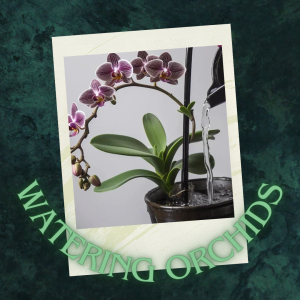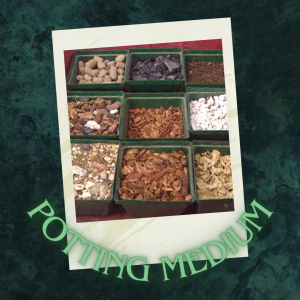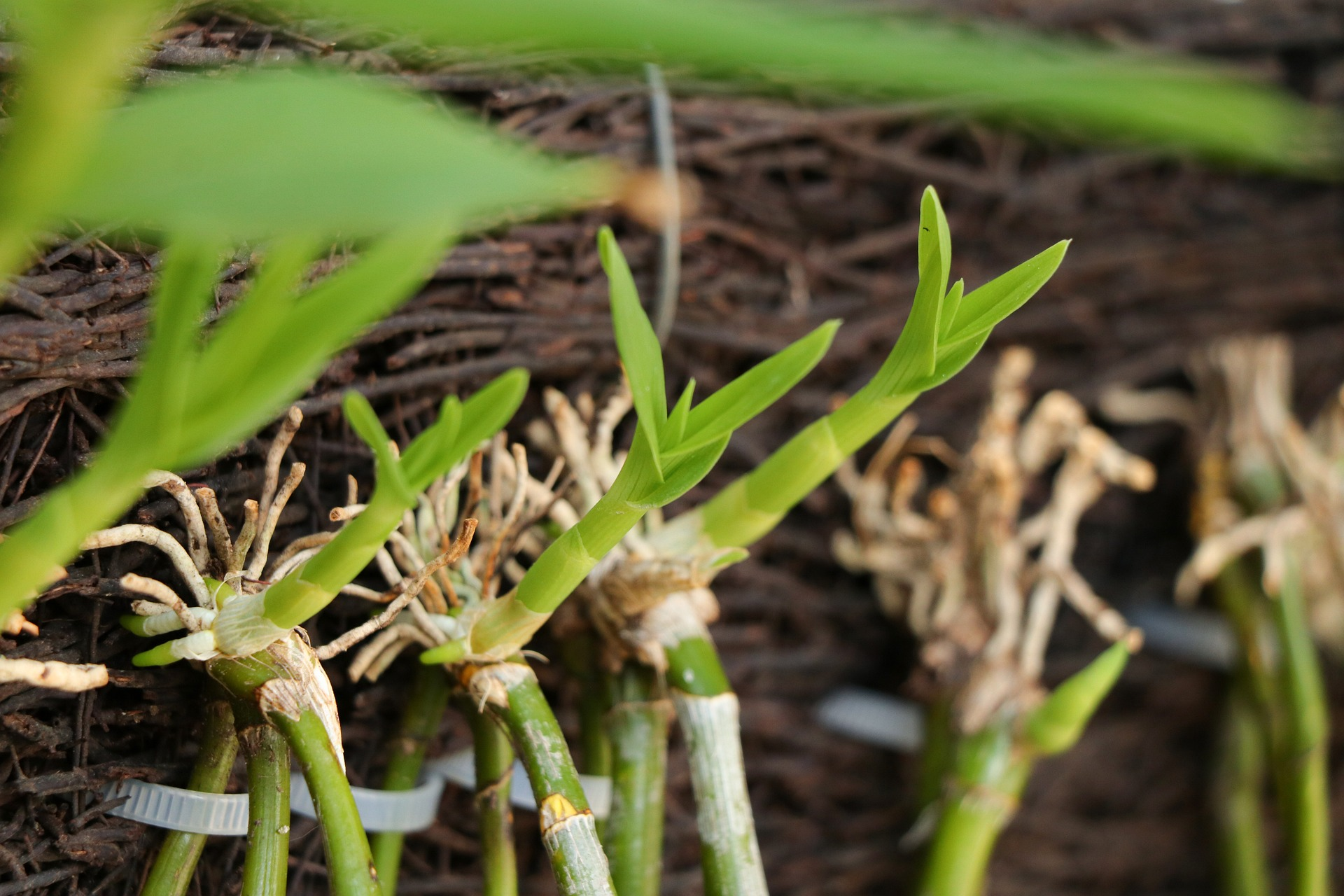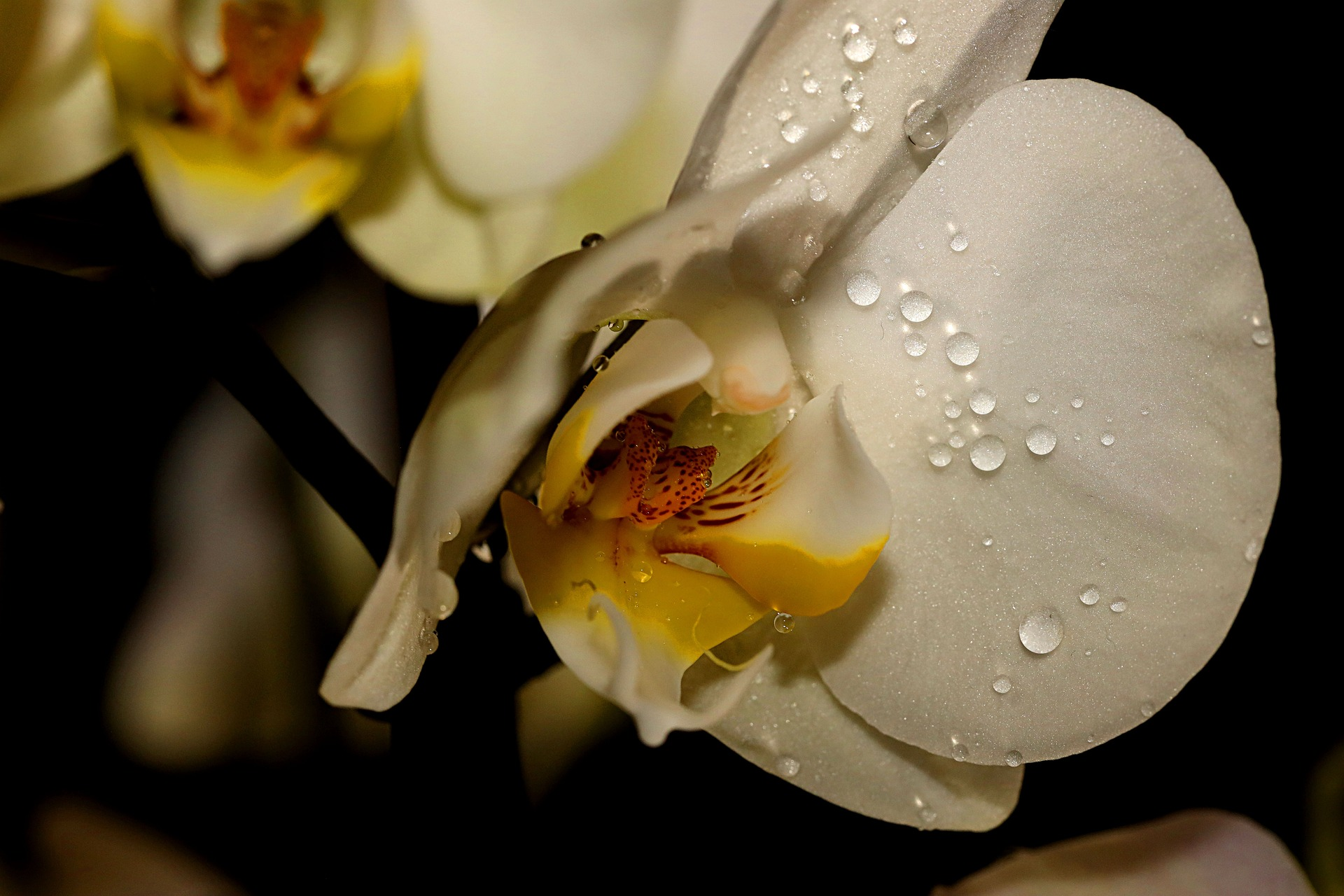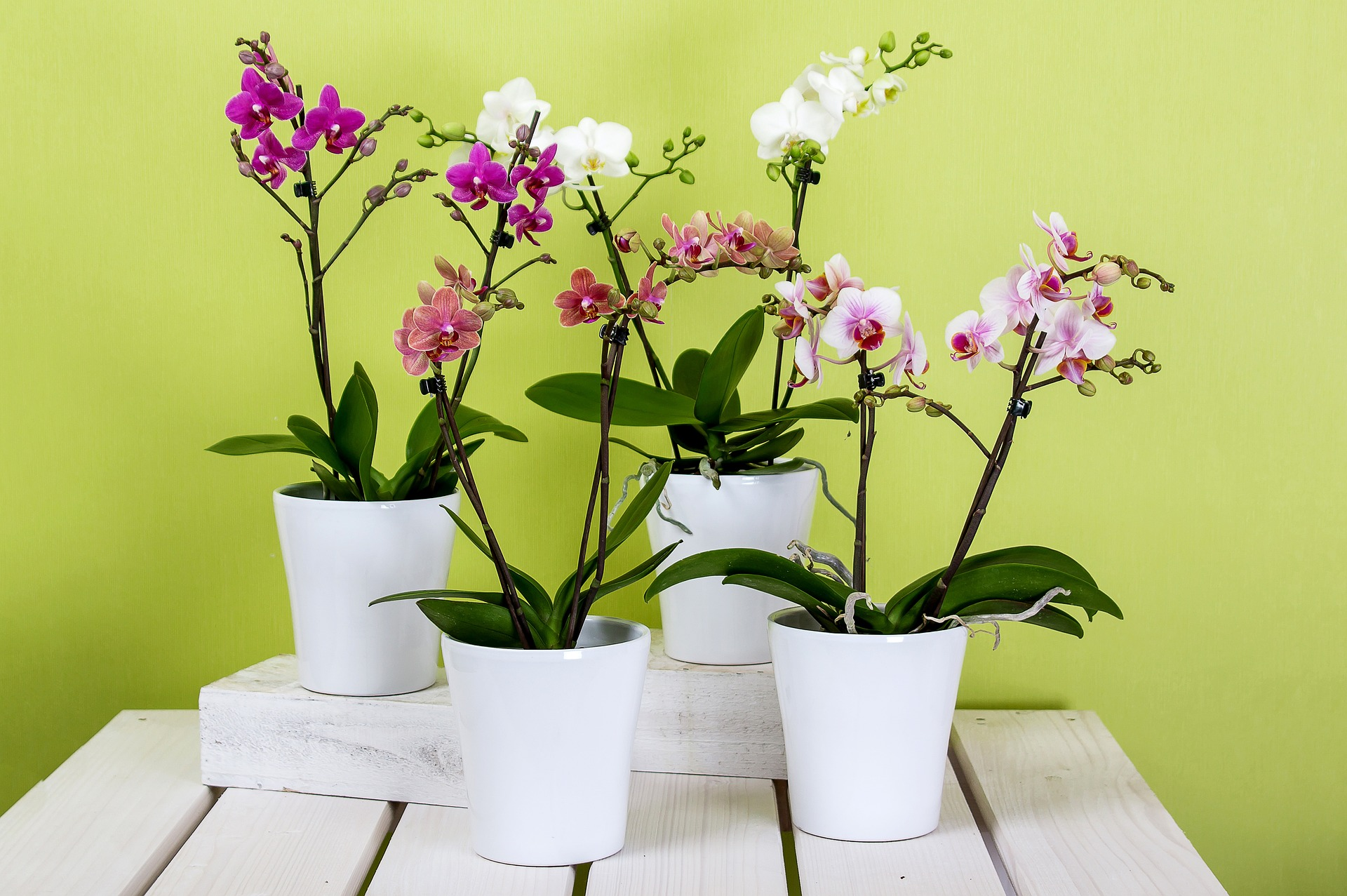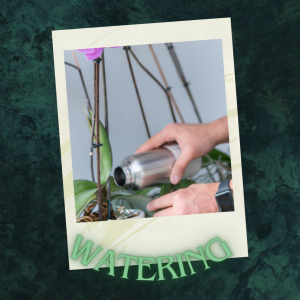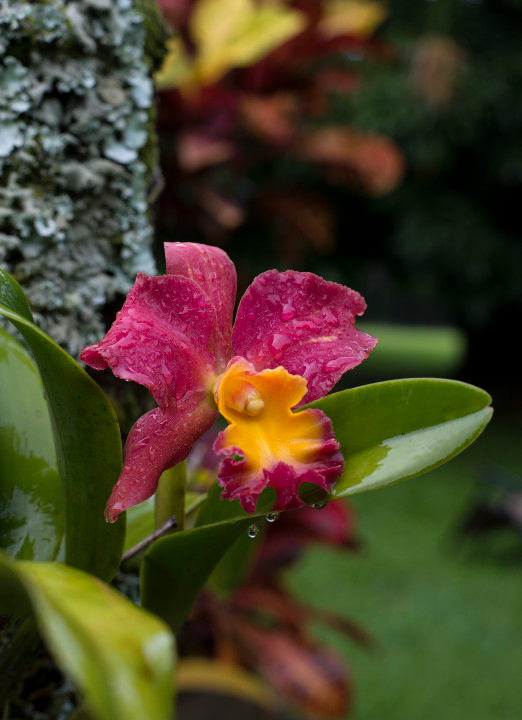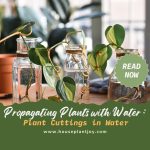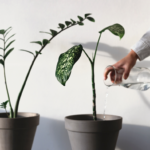HousePlantJoy is supported by our audience. When you purchase through one of our links, we may earn a small affiliate commission. As an Amazon Associate I earn from qualifying purchases. Your cost is not affected.
==================
Orchids, with their mesmerizing beauty and allure, have a special place in the hearts of many. But did you know learning to water orchids correctly is crucial to keep them thriving and flashing those blooms? If you’ve ever wondered about the ins and outs of watering orchids, you’re in the right place. Stick around, and we’ll uncover all those secrets together. Are you ready? Enjoy reading!
Understanding Orchids
You might be thinking, “It’s just a plant, right? I water my other houseplants once a week, and they’re fine!” But here’s the catch: orchids aren’t like most plants. They originally hail from humid, tropical regions. Thus, these exquisite flowering plants have adapted to some pretty unique environments.
Imagine orchids in their natural habitat, clinging to tree branches or nestling in leaf debris. The rainforest canopy above them filters light. And the humid environment ensures their roots stay evenly moist but never waterlogged. They’re actual tropical plants, after all! Understanding these conditions can help us replicate the best care for our indoor orchids.
But wait, there’s more. Have you ever noticed those thick, sometimes aerial roots sprouting from the base of your orchid plant? Those aren’t just for show. Orchid roots play a crucial role in absorbing moisture and essential nutrients. Spoiler alert: these aren’t your everyday plant roots!
So, the next time you’re admiring your orchid’s gorgeous petals, remember this. They’re a lot more than just pretty faces. Orchids potted in our homes deserve a bit of special attention to thrive. This is especially important when it comes to watering.
The Role of the Right Potting Medium
Have you ever wondered why you can’t just plop your orchid into the same old potting mix you use for other houseplants? It all comes down to the potting medium!
Remember how we chatted about orchids in their natural habitat? They aren’t lounging in soil like other plants. Instead, they’re often found hanging onto tree branches. They enjoy good air circulation and a light, fine substrate. This is where things like sphagnum moss and a commercial orchid bark mixture come into play.
Sphagnum moss can hold a good amount of water. This ensures your orchids have enough moisture without feeling like they’re taking a permanent bath. On the other hand, a commercial orchid bark mixture, often made of fir bark, allows for fast drainage and keeps those orchid roots far from root rot. It’s like choosing between a comfy memory foam mattress and a spring one. Each has its perks!
But why does this matter? The potting media you choose directly impacts water retention and plant growth. It can mean the difference between an orchid potted for success and one that’s struggling. Think of it as laying the foundation for your orchid care. And trust me, you’re setting yourself up to water orchids correctly every time.
So, next time you’re at garden centers, don’t just grab any old bag of dirt. Your orchid deserves the best!
Elevate your orchid care game with the Authentic rePotme Slotted Orchid Pots and the 100% Organic Orchid Mix. These essentials are perfect for potting and nurturing your orchids. Learn how to water orchids correctly and provide them with the best home. #OrchidCare #PottingPerfection #Ads #CommissionsEarned ??
Decoding Orchid Roots
Did you ever find yourself staring at those thick, greenish-white tendrils poking out of your orchid pot, wondering, “What on Earth are those?” Well, my friend, let’s get acquainted with the orchid roots!
First things first, those aren’t just any roots. They’re specialized structures tailored for the orchid’s unique lifestyle. When you see an orchid in its natural habitat, you’ll notice it doesn’t bury its roots underground like most plants. Instead, many orchids let their roots hang out in the open air. They soak up moisture from their surroundings. These are called aerial roots.
Now, the appearance of these roots can tell you a lot about your orchid’s health. Healthy orchid roots are usually firm, green when wet, and silvery-gray when dry. It might be a sign of over-watering if they start looking mushy, brown, or shriveled. Or worse, it could be the dreaded root rot. And trust me, you don’t want to go there!
But here’s a pro tip: those roots will guide watering orchids. If they’re silvery-gray, it’s a hint that your orchid is thirsty. But if they remain greenish, hold off on the water a bit longer.
How To Water Orchids
Alright, let’s roll up those sleeves! It’s one thing to know when to water your orchid. But understanding how to water orchids correctly can make a world of difference. So, let’s dive in!
Watering Schedule
First off, there’s no one-size-fits-all. While many plants have a set watering schedule, like twice a week, orchids like to keep us on our toes. The frequency might vary depending on factors like potting media, air circulation, and even how warm the weather turns. Wait until the top inch of the potting mix is barely damp. Do you remember our chat about orchid roots? Their color can be a handy indicator!
Right Water
Many indoor orchids are forgiving and can handle tap water. But some might prefer the purity of distilled or rainwater. Please make sure the water temperature is lukewarm. Cold water can be a shock to them. And always check the water quality. If tap water is heavily treated, other options might be worth exploring.
Watering Technique
When you water orchids, imagine them in their natural habitat. They’re used to rain showers, not a soaking tub. Take your orchid to the sink. And let the water flow through the potting mix. This ensures the roots get a good drink, allowing excess water to drain. Remember, orchids hate standing water. Ensure there’s no water left in the decorative pot or on the orchid’s water-sensitive crown to avoid crown rot.
Humidity and Moisture
Orchids thrive in a humid environment. If you’re in a place with low humidity, consider placing a tray filled with water near your orchid to increase humidity. Please make sure the pot doesn’t sit directly in the water.
Checks
Are you not sure if you should water your orchid? Use the pencil trick or a wooden skewer. Please insert it into the potting mix. If it comes out dry, it’s time to water. If it feels damp, hold off a bit.
Potting, Pots, and Drainage
You’ve probably seen or heard about those clear plastic pots. Or have you wondered about the significance of those drainage holes? Well, hang tight because it’s time to dive into the essentials of orchid pots and their pals!
Clear Plastic Pots
Transparent pots for a plant? Why?” you may wonder. Orchids, being the unique divas they are, have photosynthetic roots. This means they derive energy from light! Using clear plastic pots allows those roots to bask in a bit of sunlight. This replicates their natural habitat.
Drainage Holes
Have you ever heard of the saying, “An orchid’s worst enemy is stagnant water?” Okay, maybe I just made that up, but it’s true! Excess water is a no-go for orchids. Those drainage holes in the orchid pots are there for a reason. They allow excess water to escape. This prevents your orchid roots from taking an unwanted swim and avoiding root rot.
Choosing the Right Potting Mix
We’ve touched on this earlier, but it’s worth repeating. It doesn’t matter if you’re using sphagnum moss, a commercial orchid bark mixture, or another type of potting media. However, ensuring it provides good aeration and drainage is vital. You want something that retains just enough moisture without becoming a soggy mess.
Upsizing with Care
Orchids don’t need frequent repotting like some other houseplants. But when you decide to give them a new home, ensure the unique orchid pot is not too large. Orchids prefer a snug fit. While repotting, trim away any dead or decaying roots.
Decorative Pots and Self-Watering Pots
These can be a great way to jazz up the appearance, but always ensure room for drainage. A self-watering pot can be handy, but remember, orchids don’t like to sit in water. It’s all about balance!
Common Mistakes When Watering Orchids and How to Avoid Them
Who said gardening is without its trials? The good news is, we can learn from these hiccups. Let’s chat about some common orchid watering mistakes and how we can dodge them.
1. The Ice Cube Myth
I’ve seen this one pop up everywhere. “Water your orchid with ice cubes! It’s easy and efficient!” While it sounds nifty, our tropical plants don’t like the cold. Remember, most orchids are from warm, humid environments, and ice cubes can shock them. Lukewarm water is the way to go.
2. Overwatering
This is the granddaddy of all mistakes. And it is a leading cause of more orchid deaths than we’d like to admit. Orchids potted in a mix that stays wet for too long can suffer from root rot. What’s the solution? Get familiar with your orchid’s watering needs and potting medium. If it feels wet, hold off on the H2O.
3. Underwatering
Conversely, leaving your orchid parched could be better, too. If the potting mix is dry and the roots are silvery for too long, it’s a sign. Your orchid is pleading for a drink.
4. Using Poor Quality Water
Water quality matters, my friend. Tap water containing salts and mineralsdiscus might harm your orchids over time. Consider using rainwater, distilled water, or RO water. And always remember, lukewarm is the golden temperature.
5. Forgetting About Humidity
Orchids aren’t just about watering. They thrive in humid environments. Consider getting a humidity tray or a humidifier if your space is dry. Anything to make our green buddies feel at home is helpful!
6. Water on the Leaves
Please be careful not to leave water on the orchid’s water-sensitive crown. It can lead to crown rot, a fungal infection. Always aim to water the base, avoiding the leaves.
7. Stagnant Water in Decorative Pots
If you have a decorative pot without drainage holes, be careful. Remove the orchid pot, water it, let the excess water drain, and then place it back. Keep it from sitting in standing water.
Additional Tips For Watering Orchids
By now, you’ve got the basics down. But, as with anything worth doing, there’s always room for improvement. Here are some watering tips to keep in your orchid care toolkit.
1. The Pencil Trick
You’re wondering if your orchid needs water? Use the trusty pencil trick. Stick a wooden skewer or pencil into the potting mix. If it comes out dry, it’s time to water. If it feels damp, hold off. It’s a simple, yet influential gauge!
2. Adapt to the Seasons
Adjust your watering schedule just like you change your wardrobe as the weather turns warm or cool. Orchids typically need more water during their growth phase in warmer months and less during the cooler periods.
3. Avoid Water on Aerial Roots
These exposed roots are perfectly designed for quick air-drying. It’s best to avoid getting them too wet to prevent any potential rot.
4. Consider the Water Temperature
Have you ever jumped into a cold shower unexpectedly? It’s not fun, right? Orchids feel the same. Always use lukewarm water. It provides a gentle touch that your orchid will appreciate.
5. Air Circulation is Key
Please make sure your indoor orchids get good air circulation. It helps the potting medium dry quickly and keeps those orchid roots healthy.
6. Remember the Essential Nutrients
While it’s all about water today, don’t forget that orchids also need food. There are special orchid fertilizers out there. They ensure your plant gets the essential nutrients for those beautiful blooms.
7. Increase Humidity, Not Water
In low humidity, the instinct might be to water more. Instead, focus on increasing humidity with a water tray or humidifier nearby.
8. Check Water Quality
Avoid using water with high salt or mineral content. Water quality can significantly impact the health and longevity of your orchids.
Once more, take your orchid care to the next level with the Authentic rePotme Slotted Orchid Pots and the 100% Organic Orchid Mix. These essential tools are your gateway to potting perfection and nurturing your beloved orchids. Master the art of watering orchids correctly while providing them with the ultimate home they deserve. Elevate your orchid care journey today! #OrchidCare #PottingWisdom #Ads #CommissionsEarned ?
Wrapping It Up
Our chat about the world of orchids has been quite the adventure. We’ve covered a lot!
Remember that orchids might seem a tad demanding at first glance. But they’re just like any other houseplant—only with a dash more flair and a sprinkle of tropical charm. Watering orchids correctly is the cornerstone of orchid care. Keep the potting mix evenly moist but not soggy. Pay attention to those roots, and always use high-quality water.
Gone are the days of looking at your phalaenopsis orchids with a puzzled expression, wondering about their thirst level. With these tips, you’re well-equipped to provide them the care they deserve. And trust me, the reward of those radiant blooms is worth every drop of effort.
So, next time you reach for that watering, remember our little chat. Know that you’re nurturing a bond with one of the most mesmerizing plants with every sprinkle. Keep growing, keep learning, and happy planting!
FAQs
How often should I water my orchids?
It depends on the type of orchid, the potting medium used, and the environment. Most orchids, when potted in bark, need watering every 5 to 7 days in summer and every 7 to 10 days in winter. But always do the finger or pencil test first!
Can I use tap water for my orchids?
Ideally, you’d want to avoid straight tap water if it’s hard or treated with chemicals. Rainwater, distilled water, or RO water are better choices. If you must use tap water, let it sit overnight to let some of the chemicals evaporate.
I've heard about the ice cube method. Is it safe?
While some swear by it, most orchid aficionados, including yours truly, suggest lukewarm water instead. Remember, orchids are tropical plants and aren’t accustomed to ice-cold treatments.
Learn More About Houseplant Care!
Discover different types of houseplants and how to care for them with us! Join us on Facebook, Instagram, and Twitter for beautiful photos, plant care tips, and a community that celebrates the joy of indoor gardening.
Facebook: https://www.facebook.com/houseplantjoyblog
Instagram: http://instagram.com/houseplantjoy20
Twitter: https://twitter.com/HouseplantJoy
Let’s nurture our green spaces together!
Read More
More Interesting Links:
Outstanding Benefits of Having Orchid Flowers At Home(orchidrepublic.com)


